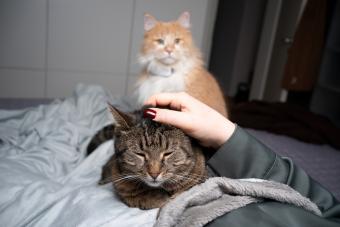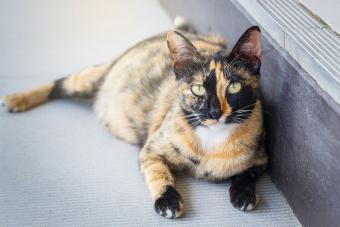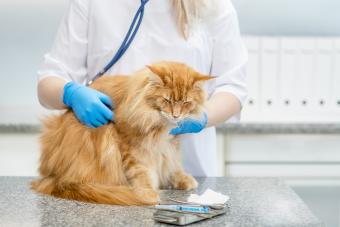
If you're concerned that your kitty seems a bit more confused than normal, it helps to understand some of the possible reasons for disorientation in cats. From feline vestibular disease to the possibility of rat poison or another toxin, there are several potential causes for dizziness, wandering, and behavioral changes.
Possible Causes for Feline Disorientation
When a cat displays signs of disorientation, such as stumbling, incoordination, circling, wobbling, head tilting, weakness, or confusion, it can be a sign of a severe problem. These seven possible causes can give you more insight into what could be going on with your cat.
Feline Cognitive Dysfunction
Disorientation is often observed in senior cats. In fact, the American Society for the Prevention of Cruelty to Animals (ASPCA) states that as many as 55 percent of senior cats aged 11 to 15 years old suffer some level of cognitive dysfunction, sometimes referred to as feline senile dementia. That statistic rises to 80 percent for cats aged 16 to 20 years old.
The Cornell Feline Health Center (CFHC) at Cornell University also agrees that the natural aging process can affect a cat's brain and lead to:
- Disorientation
- Wandering
- Memory loss
- Irritability
- Increased vocalization
- Behavioral changes
Reaching a Diagnosis
To reach a diagnosis of feline cognitive dysfunction, a vet will look for a specific medical cause for the symptoms. If medical causes can be ruled out, the symptoms may be attributed to cognitive dysfunction.
Treating Cognitive Dysfunction
According to Shawn Messonnier, DVM in an article published by Integrative Veterinary Care Journal, feline cognitive dysfunction may be treated with supplements, such as:
- SAMe - SAMe or S-adenosylmethionine increases serotonin and dopamine levels and, ultimately, improves brain function
- Choline - This vitamin supports normal cell structure and function and can reverse signs of cognitive dysfunction
The effects of cognitive dysfunction, including disorientation, may be lessened with treatment, but there is no cure for the condition. Environmental adjustments can also help, such as sticking to a rigid feeding and nighttime schedule, placing more litter boxes around the house to avoid accidents, pheromone sprays to address anxiety, or the addition of nightlights for improved orientation.
Feline Vestibular Disease
According to PetMD, head tilting and disorientation may be signs of vestibular disease. The vestibular system is part of the inner ear, and when it doesn't function properly, it can make a cat feel off balance. Key symptoms include:
- Tilting the head at angles that aren't in alignment with the rest of the cat's body
- Walking in circles and stumbling
- Nystagmus (involuntary darting of the eyes)
- Nausea of vomiting
Reaching a Diagnosis
Vestibular disease can be difficult to diagnose because the exact cause(s) of the disorder aren't fully understood. In order to reach a diagnosis, an affected cat will need a thorough physical examination, including a careful examination of the inner ears to look for signs of infection or tumor. The vet may also choose to run a blood work up and urinalysis to look for other sources of infection that could produce the symptoms. Additionally, the owner will need to provide the cat's history leading up to the onset of the disorientation and head tilting.

Treating Vestibular Disease
Treatment may include antibiotics as well as temporary hospitalization if the symptoms are severe. Many vestibular cats are nauseous due to feelings of vertigo, so antiemetic medications are usually necessary. They'll need to be monitored carefully or even confined to prevent injury as a result of stumbling or falling over. Chances for complete recovery are high in most cases, although some head tilting may continue even after treatment.
Seizures
Seizures are caused by a misfiring of neurons in the brain, although exactly why the neurons begin misfiring is still a bit of a mystery. According to an article written by Race Foster, DVM, cats are usually disoriented in the aftermath of a seizure, called the post-ictal phase, as they try to recover. The post-ictal stage can last anywhere from 24 to 48 hours. It's possible for a cat to experience a seizure while it's out of its owner's sight, then act disorientated in front of the owner at a later point. Characteristics of a seizure include:
- Uncontrolled body movements
- Salivating
- Involuntary urination and/or defecation
Reaching a Diagnosis
A vet will gather details about the cat's history from the animal's owner in order to understand how frequently the seizures occur, as well as clues about what may trigger them. The vet will also run diagnostic tests in an effort to determine if a medical condition, such as diabetes, hypoglycemia, a brain tumor, a brain injury, or some other condition, is the underlying cause for the seizures. An MRI or spinal tap can give more insight into the origin, though some are idiopathic, meaning the cause is unknown.
Treating Seizures
Medications, such as Phenobarbital or Levetiracetam, are often prescribed to help control the seizures and reduce their frequency and severity. Depending on the cause, there may be no cure for the seizures, so an affected cat will likely remain on anticonvulsant medication for the rest of its life.
Feline Infectious Peritonitis (FIP)
Feline infectious peritonitis, often referred to as FIP, is a viral disease caused by specific strains of feline coronavirus (FCoV). According to VetInfo.com, the disease has a wet and a dry form, and it's the dry form that can cause a cat to appear disoriented. This occurs when granulomas, masses of inflamed tissue, form in the central nervous system. Along with disorientation, other neurological symptoms of dry FIP may include:
- Behavior changes
- Loss of balance
- Convulsions or seizures
Reaching a Diagnosis
FIP is diagnosed by comparing a cat's history to the clinical signs it shows, as well as the results of several laboratory tests. For cases of wet FIP where a cat has an accumulation of fluid in their abdominal cavity, a diagnostic called the Revalta test can be performed on the fluid. However, the surest way to determine if a cat has FIP is for a vet to biopsy affected tissues, but this typically only occurs after an affected cat has passed away.
Treating FIP
Historically, there has been no cure for FIP, so treatment has consisted of supportive care, such as IV fluid administration, providing high-quality nutrition, and Prednisolone therapy. However, emerging data suggests that an oral anti-viral medication, known as GS-441524, may treat and even cure FIP in cats. This drug is not yet FDA approved and can be challenging to acquire.

Rat Poison
According to Cornell University's College of Agriculture and Life Sciences, the rodent poison sodium fluoroacetate, sold under the commercial name "1080" or "Compound 1080," can cause neurological signs, such as:
- Disorientation
- Aimless wandering
- Confusion
Reaching a Diagnosis
Cats typically ingest the chemical when they eat a rodent that has consumed the poison. Poisoning is suspected based on the symptoms, as well as any information an owner may be able to provide about whether the rat poison was used in the cat's environment. A suspected diagnosis of poisoning is usually confirmed by performing a necropsy to determine the cause of death.
No Treatment Available
Unfortunately, respiratory failure typically occurs between 2 to 12 hours after the first signs of 1080 poisoning are noticeable, and there is no antidote to reverse the toxic effects.
Ingesting Toxic Foods
The ASPCA also lists a couple edible items that can make cats disoriented if they ingest them.
- Bread dough - Once eaten, the yeast in the dough metabolizes the sugar and produces alcohol, which is then absorbed into the cat's bloodstream and causes intoxication. The cat appears drunk and disorientated, and it may eventually vomit the dough. The animal may also have a swollen abdomen due to the dough expanding inside its stomach. Any cat that shows these signs should be monitored by a veterinarian.
- Alcohol - Cats may have access to alcoholic beverages if their owners leave their drinks unattended. Felines are typically drawn to creamy cocktails, but they may take a drink out of any glass they encounter. Drunken disorientation and stupor are the major signs a cat has consumed alcohol, and the animal's ability to recover depends on just how much alcohol it consumed. Cats are very sensitive to alcohol and can die from alcohol poisoning quite easily, so an owner should contact a veterinarian right away if they suspect their pet may have shared a drink.
THC Toxicity
Tetrahydrocannabinol (THC) is the primary psychotropic compound found in marijuana, and it can make pets appear intoxicated when ingested. Cats who consume any plant or product containing THC may experience:
- Disorientation or incoordination
- Agitation
- Lethargy
- Hypersalivation
- Leaking urine
- Slow or shallow breathing
- Difficulty thermoregulating
- Tremors
- Dilated pupils
Reaching a Diagnosis
In general, a physical exam and thorough history will lead veterinarians to a diagnosis of THC toxicity. Blood work is typically performed to rule out any other causes of the presenting symptoms. Urine drug-screening tests designed for humans are commonly used in the veterinary hospital, however, they are not always accurate. It can also be challenging to collect the required volume of urine from a small pet such as a cat, particularly if they are leaking urine.
Treating THC Toxicity
Typical treatment involves the induction of vomiting to remove any THC from the cat's stomach followed by oral activated charcoal to prevent further absorption of the toxin. Supportive care, including IV fluids and careful temperature, respiratory, and cardiac monitoring may be necessary. Most cats recover well with prompt treatment and care.
Call Your Vet Immediately
Disorientation can be a sign of significant illness, so don't take it lightly. Put your pet in a safe place, such as a carrier, and contact your vet. Your vet is the most qualified person to diagnose your pet and provide the most effective treatment, even if that treatment is just providing supportive care until the cat either recovers or passes away. Swift action on your part could save your pet's life, or at least ease their discomfort, so call your vet right away at the first sign of disorientation.







